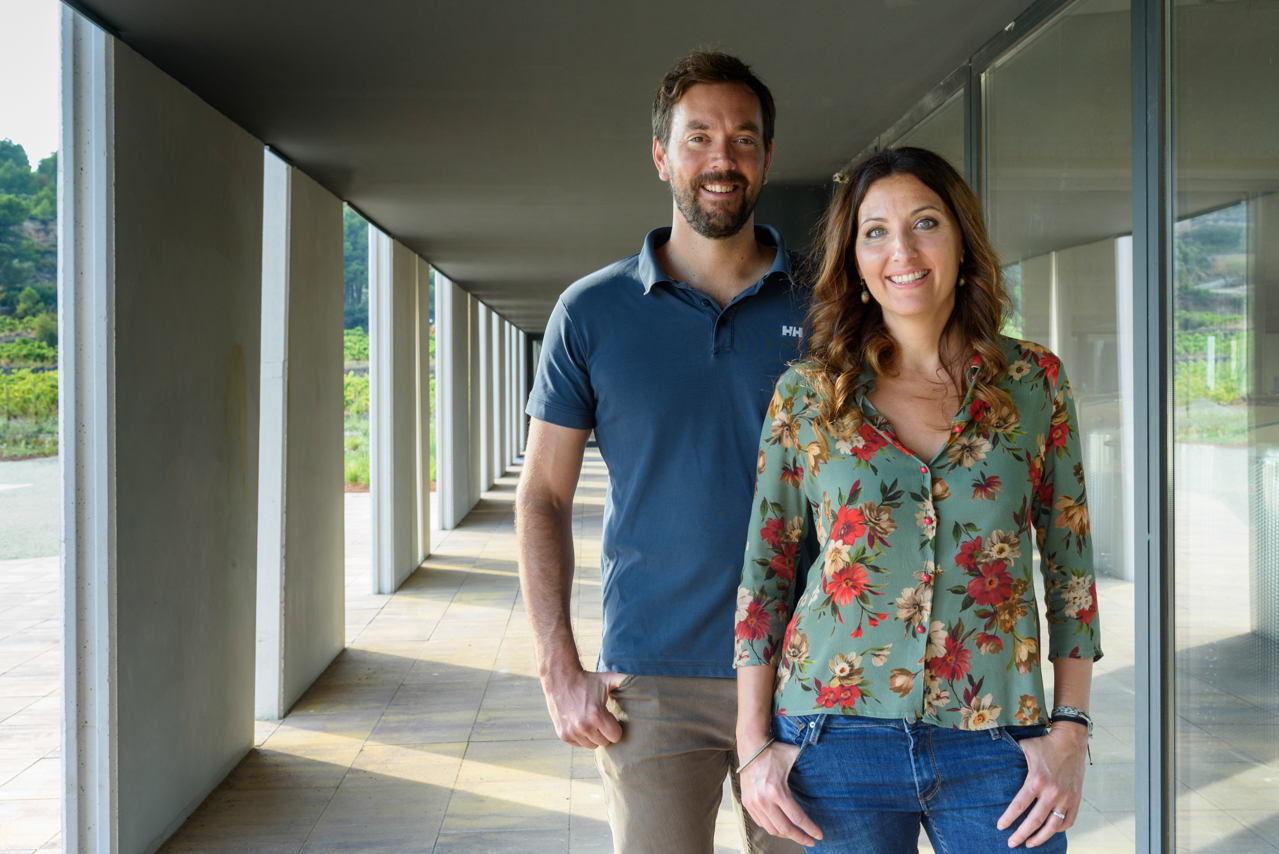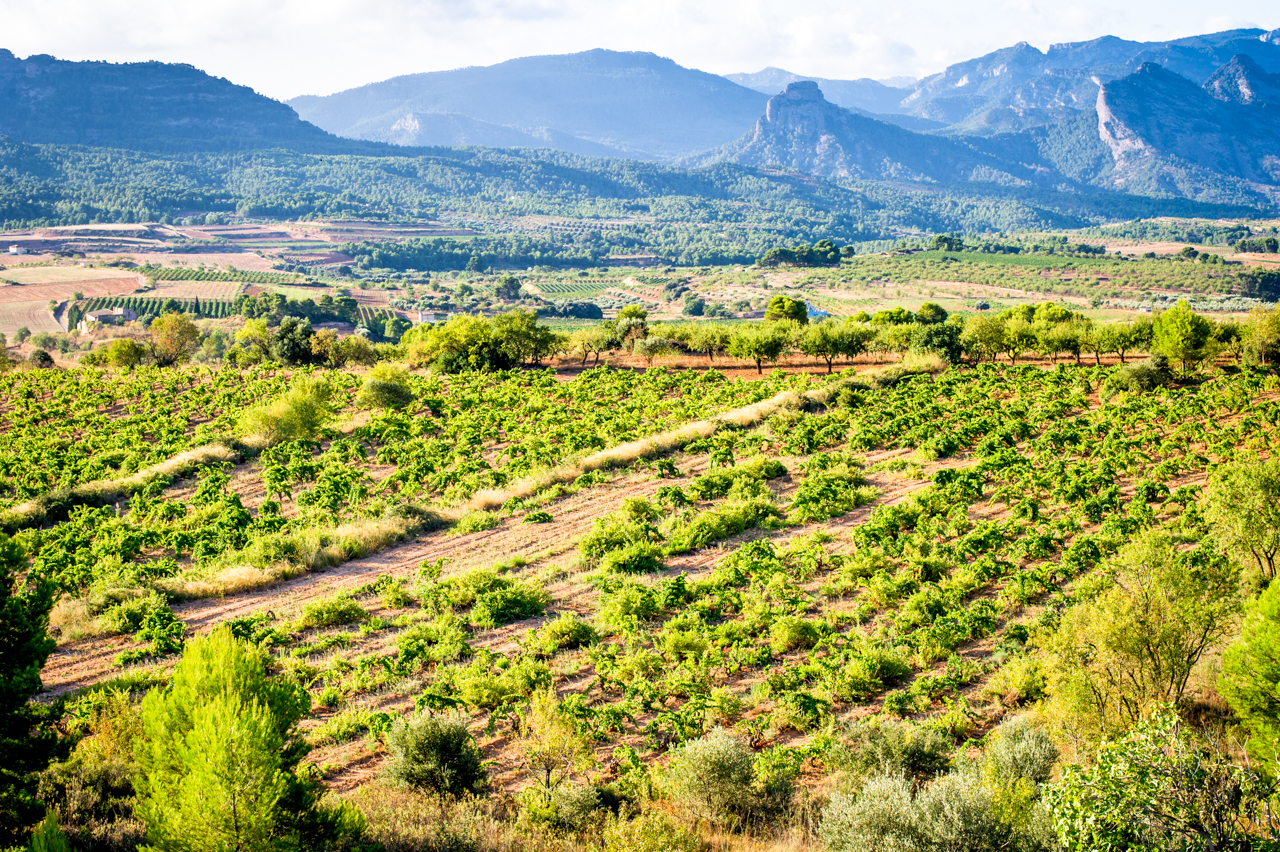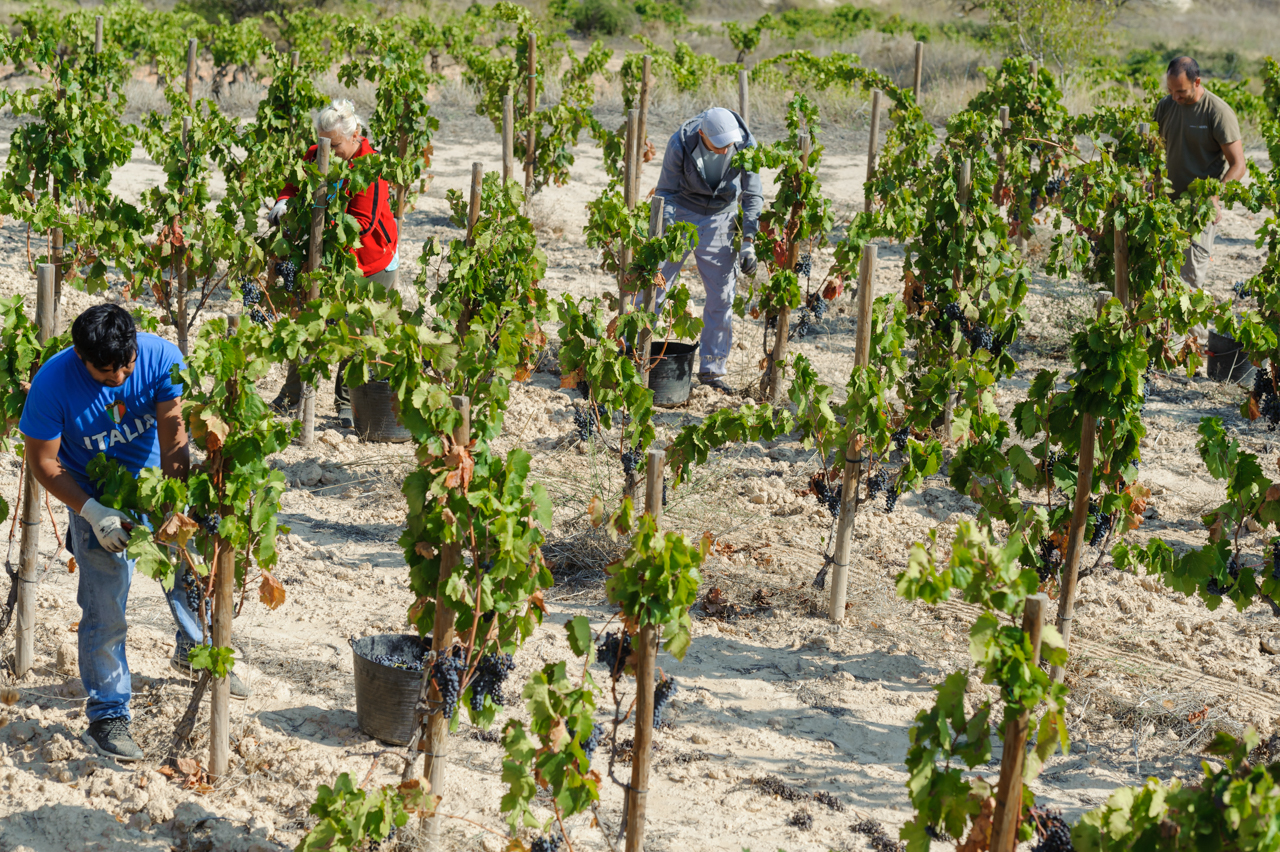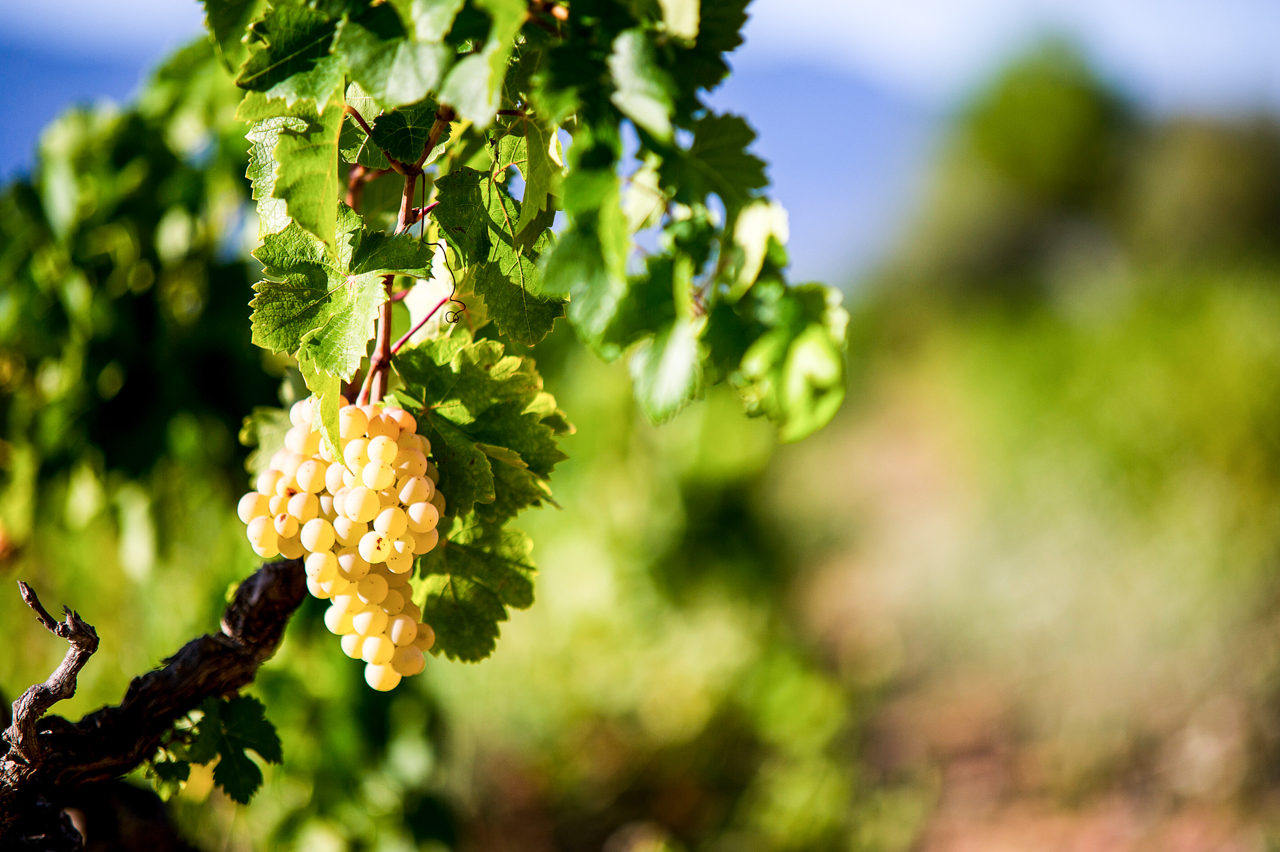


Rafael de Haan and Nuria Altés of Herència Altés
Q: How did you each get your start in the wine business?
Nuria Altés: I studied agriculture at the local school in Terra Alta, and then I started working at the cooperative in the town where I was born and grew up. My family had always been involved in wine. Everybody makes wine here because there is really nothing else to do. I did everything, laboratory, viticulture, vinification, selling, so every factor in the wine business. Eventually, they gave me the opportunity to become the sales manager, and I started in Catalonia and afterward in export. In 2005 I started working with Rafa making wine in different parts of Spain. Then, in 2010, we felt the need to return to our land, pick the grapes of my family, and make our first wine with my family’s name, Altés.
Rafael de Haan: I was born, raised, and educated in England, and my education was utterly unrelated to wine. I graduated in history with a Master’s in Latin American Studies and first encountered wine professionally working for my family’s company in the UK. So my first real job was heading off to South America, researching the wine industry in Chile and Argentina, and developing some relationships between the UK company and the Chilean and Argentine producers. After finishing my Masters, I decided I wanted to move to Spain. Having no better plan at the time, I thought, why don’t I get back into the wine industry? So that’s when I started to act as a broker between Spanish producers and UK and US importers. That lasted for a few years, and then it became more official through incorporating a company, meeting Nuria, and moving more toward becoming a producer. We wanted to be more involved in the production of wine rather than just selling someone else’s product. I hadn’t had a direct route to that side of things until I met Nuria, getting to know her parents, the growers, falling in love with the whole ethos of being a wine producer.
When did you first meet Eric Solomon?
Rafa: I think it was 2008 when we presented some Terra Alta wines to Eric and Daphne. But somewhat ironically, we started working with Creta from Ribera del Duero first. We went with Terra Alta wines and came back with an order for Ribera del Duero. I think it was just an opportune moment because Eric was looking for a Ribera del Duero at that time, and I happened to be working with a winery that suited the project. Then a couple of years later, when we started Herència Altés, it was the right project at the right time. I don’t want to be too sycophantic, but the support that European Cellars gave us at the time was essential for us to grow Herència Altés from something tiny and insignificant to what it is today, especially in those early years when you need a backer, someone who can really help you take it to the next level.
Nuria: Eric was very interested in Herència Altés, and that helped us to grow very quickly. So we had the opportunity to introduce our wines in the US first, and that gave us some oxygen to develop sales in other countries.
Much has changed in the decade since you established Herència Altés. Which changes would you consider to be the most significant?
Nuria: In terms of vinification, we’ve changed so much. First, we had to begin organic viticulture, and only then could we understand our soils. This needed time and is very slow, step by step. And I think we did it correctly, first organic farming and then minimal intervention winemaking. Now we don’t add any yeast, so everything is spontaneous fermentation. We add nothing and just let the grapes express themselves.
Rafa: When you start out, you do what you can to survive. You have to make compromises, and you have to work with the resources available, the facilities available at the time. So those first five years, we adapted to circumstances, working in other people’s facilities, buying grapes, and the wines were good, but by no means were they what we would consider optimal. Now that we have our own winery, we have a team of 21 people working for Herència Altés. We have a team just for farming. We have a team just for winemaking, so we’re all building something that’s much bigger than what really started to be just a humble collection of wines.
Terra Alta has a long history of winemaking. Why do you think it isn’t better known?
Nuria: Terra Alta is far away from everywhere in Spain, so we need to show all our potential and all its history. Very close to the winery, we have an ancient Iberian town where they found stone wine vats from the third century BC, with traces of winemaking. Also, in the vineyards near our winery, they’ve discovered a Roman town built after the Iberians. We are also located in front of the mountains of the river Ebro, the Parc Naturel dels Ports, and this is the natural barrier between the Mediterranean Sea and our home. This was the site of the Battle of the Ebro, which was the largest and one of the last battles in the Spanish Civil War. So, we again we always talk about ancient and contemporary history, which is very important in this area. Terra Alta is all about storytelling when we talk about wine. This is difficult to explain when people have not visited. So, they need to see it for themselves because how can you translate all this information through a bottle of wine?

The sweet spot of Terra Alta – panal soils, proximity to the mountains, exposure to the çirc & garbi
There is a lot of Garnatxa in Spain, especially from the D.O.s in Aragón nearby, so how are Terra Alta and Herència Altés unique?
Rafa: In a word freshness…
Nuria: Freshness, yes, because there is a big difference between Aragon Garnatxa, which is more black-fruit, and we are more red-fruit. And for me, it is the climate because we are more Mediterranean, but with this continental influence. We have two winds, the garbí which comes from the sea, and which is very fresh. And in Aragon, they don’t have this moderating influence. We also have the cerç which they also have in Aragon, a dry wind coming from the north. And these two winds are important for organic viticulture because it helps to dry the vines and prevent disease. But the garbí is very important because it blows at night in summer, and it maintains an oscillation of temperature that’s quite different from Aragón. Also, we have a lot of Garnatxa Blanca, which they do not have in Aragón.
Rafa: There is also a sweet spot in Terra Alta, which is between 400 and 500 meters above sea level, and particularly for vineyards with eastern and northern exposures like ours, which are exposed to these breezes that Nuria was talking about. I wouldn’t say the whole of Terra Alta has the same terroir. I think there is definitely a sweet spot where you find this freshness. Many regions have lots of old vines, and they can get concentration, drought-resistance, and have this wonderful grace. But what distinguishes Terra Alta with its old vines is this freshness coming from the altitude between 400 and 500 meters and that freshness coming from the breezes. And I should also add the calcareous soils, which are not exclusive to Terra Alta, but it certainly helps maintain that freshness as well.
There is a unique soil to this part of Terra Alta. Could you explain how it came to be here?
Nuria: We have a unique calcareous soil which is called panal. It is a sandy soil that partly originated in the Sahara, which through the garbí has been brought to Terra Alta. And the fact is, if we didn’t till our vineyards, the panal would form dunes.

Harvest in 2017 showing the panal soil
You’ve referred earlier to the uniqueness of Garnatxa Blanca in Terra Alta, can you explain why there is more of this variety planted here than anywhere else in the world?
Nuria: Garnatxa Blanca was planted here as far back as the 17th century because our ancestors recognized that this is a variety adapted to the dry weather of Terra Alta. When young and unirrigated, it suffers a little bit in August, but it adapts very well over time. And even in a difficult year of little rain, Garnatxa Blanca remains very fresh here. So, we have the formula. We have the variety that is perfect for this area.
Rafa: One thing always worth discussing is the versatility and complexity of the Garnatxa Blanca. It’s a great variety. We’re currently making five wines, which are 100% Garnatxa Blanca, so three dry, elegant white wines. Then we make an orange wine, which has five weeks of skin contact and two years of oxidative aging in half-filled barrels. And then we’ve also recently made a sweet wine…
Nuria: Well, it is recently bottled because we’d harvested it in 2013, and the wine was five years in a small barrel and two years in a tank. So, we just bottled it a couple of months ago. And it’s really interesting because we first dried the grapes in the vineyard and then on a rooftop. It was tiny production because it was Garnatxa Blanca from the north of Terra Alta, and the maturation was later. That’s why we decided to make a sweet wine. But when we moved from the old winery, we asked, where is the sweet wine? We had to look around for it. It is quite interesting because it is so fresh but sweet too.
About 50% of your vines are Garnatxa Blanca, what is the remaining 50%?
Nuria: Yes, about 50% is Garnatxa Blanca, and a lot of it is old vine because traditionally, Terra Alta was known for the quality of its white wines.
Rafa: And we have a lot more old vines of Garnatxa Blanca than the rest.

Garnatxa Blanca
Are you using massale selection from your old vineyards to plant new vineyards?
Nuria: Yes. Actually, for 5 or 6 years now, the Institute of Catalan Wine has been following our old vine Garnatxa Blanca to find an authentic variety of Garnatxa Blanca. They are pruning and harvesting every year to study these vines because they were planted at the beginning of the 20th century, so they are really old.
And are those old vineyards 100% Garnatxa Blanca?
Rafa: There are some other old vines interspersed in the Garnatxa Blanca.
Nuria: Maybe a little Malvasía and we also located some Garnatxa Gris
I was going to ask that because in old vineyards of Garnatxa, you frequently find a little Gris.
Nuria: We’ve planted a little of it here at the winery, and we also have old vines of Garnatxa Peluda that we purchase. It is a very interesting variety, and there is a lot of Garnatxa Peluda in Terra Alta. When they originally planted it, they just called it Garnatxa because they really didn’t recognize a difference between Peluda and Negre at the time, but it’s completely different, very different.
Rafa: We definitely love Garnatxa Peluda and we have a 100% cuvée, La Pilosa. But we also love Peluda because it enables us to add a little bit of freshness to the other cuvées. We find that it’s slightly higher-yielding and more vigorous. We haven’t been farming Peluda for many years, so we’re still learning a lot about it. If you don’t get a good growing season, you’re in danger of getting some greenness within the clusters. So, you have to be cautious of that. 2015, 2016, and 2019 were excellent vintages. 2018, 2020 were more difficult, and 2021, I think, is going to be hard, but if you select well both in the vineyard and on the sorting table, then you should be okay.
So overall, aside from Garnatxa Blanca, our vineyards are 30% Garnatxa Negre and 20% would be Syrah and Garnatxa Peluda. And a little bit of Carinyena, but it is tiny, so I guess somewhere, we’d have to add about 5% Carinyena.
Are you using any whole clusters in your fermentations?
Rafa: The plan for the reds was to get to 100% whole cluster, but we’ve had to backtrack from that in light of recent vintage conditions. We’ll probably do 15-20% in some of the cuvées and with the riper grapes that come in. Historically, the last three years, we’ve been doing up to 30-40% whole cluster, we’ve done a couple of 100% whole cluster fermentations, but we’ve dropped back slightly because we think it is too much. Too much herbaceousness comes through. So we’re learning still, and technically, it’s not easy. We built our wine in a way that is not easy to do whole cluster fermentations. We’re trying to come up with clever solutions to be able to do that in more than just a small barrel.
I recall from my visit that you have stainless steel tanks for fermentation, and concrete tulips. Do you use any oak vats?
Rafa: We’ve got some conical oak vats, small scale, so 500-1500 liter, but most of the fermentation for the village wines takes place in stainless, and for the parcel and single-vineyard wines, we use concrete.
And aging?
Rafa: For Herència Altés, the wines you know and work with, it is exclusively foudres – so 5000-liter Austrian oak foudres.
Nuria: Yes, for Garnatxa Peluda and Garnatxa Negre we use the big foudres. And the 500 and 600 liters we use for the Syrah and Carinyena which have more structure, and the smaller barrels for the orange wine.
Part 2 of this interview details Nuria and Rafa’s work towards zero emissions in Going Green in Terra Alta.
